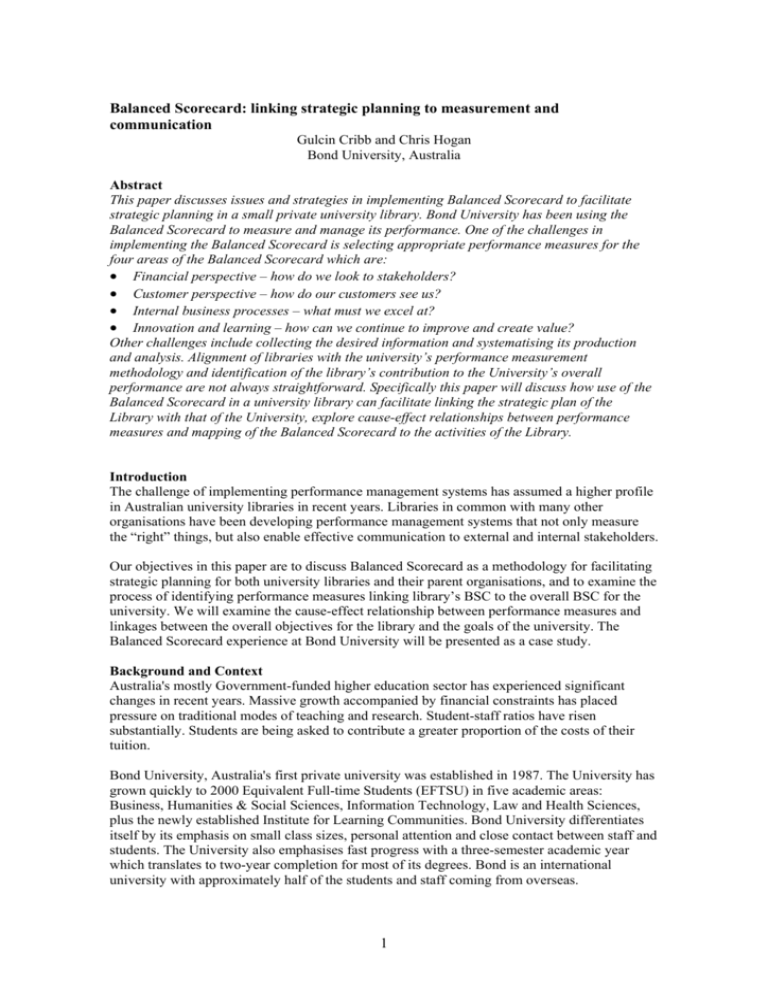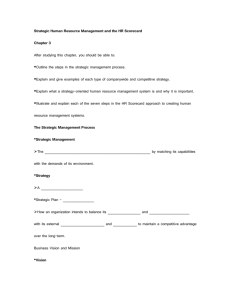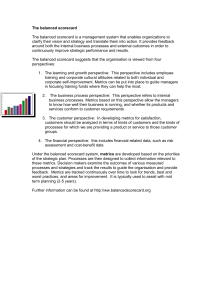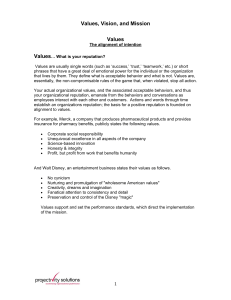1 Balanced Scorecard: linking strategic planning to - Purdue e-Pubs
advertisement

Balanced Scorecard: linking strategic planning to measurement and communication Gulcin Cribb and Chris Hogan Bond University, Australia Abstract This paper discusses issues and strategies in implementing Balanced Scorecard to facilitate strategic planning in a small private university library. Bond University has been using the Balanced Scorecard to measure and manage its performance. One of the challenges in implementing the Balanced Scorecard is selecting appropriate performance measures for the four areas of the Balanced Scorecard which are: • Financial perspective – how do we look to stakeholders? • Customer perspective – how do our customers see us? • Internal business processes – what must we excel at? • Innovation and learning – how can we continue to improve and create value? Other challenges include collecting the desired information and systematising its production and analysis. Alignment of libraries with the university’s performance measurement methodology and identification of the library’s contribution to the University’s overall performance are not always straightforward. Specifically this paper will discuss how use of the Balanced Scorecard in a university library can facilitate linking the strategic plan of the Library with that of the University, explore cause-effect relationships between performance measures and mapping of the Balanced Scorecard to the activities of the Library. Introduction The challenge of implementing performance management systems has assumed a higher profile in Australian university libraries in recent years. Libraries in common with many other organisations have been developing performance management systems that not only measure the “right” things, but also enable effective communication to external and internal stakeholders. Our objectives in this paper are to discuss Balanced Scorecard as a methodology for facilitating strategic planning for both university libraries and their parent organisations, and to examine the process of identifying performance measures linking library’s BSC to the overall BSC for the university. We will examine the cause-effect relationship between performance measures and linkages between the overall objectives for the library and the goals of the university. The Balanced Scorecard experience at Bond University will be presented as a case study. Background and Context Australia's mostly Government-funded higher education sector has experienced significant changes in recent years. Massive growth accompanied by financial constraints has placed pressure on traditional modes of teaching and research. Student-staff ratios have risen substantially. Students are being asked to contribute a greater proportion of the costs of their tuition. Bond University, Australia's first private university was established in 1987. The University has grown quickly to 2000 Equivalent Full-time Students (EFTSU) in five academic areas: Business, Humanities & Social Sciences, Information Technology, Law and Health Sciences, plus the newly established Institute for Learning Communities. Bond University differentiates itself by its emphasis on small class sizes, personal attention and close contact between staff and students. The University also emphasises fast progress with a three-semester academic year which translates to two-year completion for most of its degrees. Bond is an international university with approximately half of the students and staff coming from overseas. 1 The Balanced Scorecard Concept Bond University has developed a corporate Balanced Scorecard, which focuses on, and monitors four perspectives, Customer, Financial, Internal Business and Innovation and Learning. The University's approach to the Balanced Scorecard is based on the work of Kaplan and Norton (Kaplan and Norton 1992). As such the Balanced Scorecard is designed to overcome shortcomings of previous performance measurement systems which tended to focus on past financial performance and did not always identify areas for strategic improvement. Bond's Balanced Scorecard translates the University's mission and goals into a set of objectives, measures and targets in the above four perspectives. The framework of Bond's Balanced Scorecard is set out in Figure 1. Figure 1: Bond University’s Balanced Scorecard A Balanced Pathway to Development Customer Perspective Objectives Measures Targets How do our customers see us? Internal Business Objectives What must we excel at? Measures Innovation and Learning Targets Mission, Vision and Strategic Goals How can we continue to improve and create value? Objectives Measures Financial Perspective Objectives Measures Targets How do we look to stakeholders? The University has developed initiatives to support the achievement of targets in each of the perspectives. Progress against targets and progress with implementing initiatives is assessed on a regular basis. Each academic and support division (including the Library) is now in the process of developing and reporting progress within subsidiary Balanced Scorecards. These are linked to the corporate scorecard but have objectives, targets and measures as appropriate to their areas of responsibility. Through the Balanced Scorecard, the University aims to monitor both its current performance and its efforts to provide teaching, learning and research activities of the highest quality, improve customer services, streamline key processes, provide an environment in which its employees are motivated and developed, and enhance information systems. A single management report prepared each Semester provides an assessment of many disparate elements of the University's strategy. 2 Targets As part of this process, the Library is implementing a subsidiary Balanced Scorecard to formalise existing measures of its activities, communicate its strategic objectives to all its stakeholders and ensure alignment between the Library and the University’s strategic plan. Identifying performance measures Each organization and unit adopts its own path in building a Balanced Scorecard. At Bond University, the Library chose to follow reasonably closely the process adopted for developing the corporate scorecard. This includes a systematic development plan, involving staff at all levels of the organisation. The process for the construction of the scorecard, adapted from the typical project outline provided by Kaplan and Norton (Kaplan and Norton 2000) includes several stages. The Library had well-established strategic plans and was already collecting a plethora of statistics and other data using a range of measurement tools. These were mainly input measures which are helpful to answer the question “are we doing things right?” but not so helpful in answering the “are we doing the right things” question. From the outset, it was decided that the Library wanted a holistic strategic management system using the Balanced Scorecard framework linked to the University’s Balanced Scorecard. In addition it was envisaged that the Library also wanted to encourage the development of subsidiary scorecards over time for the business units making up the Library. In developing the Library’s Balanced Scorecard, each manager had access to key internal documents, which specify the University’s, and the Library ’s vision, mission and strategies, and performance. These included the University’s Strategic Plan, reports of reviews of processes, financial reports and existing reports of statistical information. In addition, relevant papers from the literature on performance management and the balanced scorecard were made available to the planning group. A considerable range of data and previous surveys and information available from various library organisations were also utilised. In constructing the preliminary scorecard, reference was made to the Benchmarking Manual for Australian Universities (McKinnon, Walker et al. 1999) and work being undertaken at other universities in Australia and overseas in developing balanced scorecards. McKinnon et al identify a basic set of potential performance indicators for library and information services and list examples of good practice. The manual also articulates the cause-effect relationships between performance measures for libraries and those of their parent organisations. At Bond University Library, groups of senior and middle managers were asked to provide input on the strategic objectives and tentative proposals for measures through a variety of methods. In order to determine meaningful indicators it was essential to start at the strategic level and then ask a series of questions to determine key outcomes. One of the initial questions asked was; what processes must function effectively to achieve the things stakeholders regard as important and secondly; what information could be collected to help judge the degree to which they are operating effectively. A key activity at this stage was to trace the relationships and linkages between key performance outcomes in each of the perspectives to the related performance drivers. These relationships needed to be described transparently in order to achieve a balanced strategic plan and scorecard. The cause-effect and linkage aspects of the Balanced Scorecard are critical to achieve the cascading of the Balanced Scorecard to all levels of staff and to all activities (Walsh 1996). In our case, this involved linking the measures through a series of cause and effect relationships to describe the Library’s strategy. This process was critical not only to unite the linkages but also to describe the “how” of value creation using a common framework and language. Universities, like many other organisations are made up of seemingly disparate elements. The Library is just one element within the wider organisation. The cause-effect linkages assist the 3 stakeholders, both internal and external to understand the strategy as a whole, rather than focusing on its component parts. The linkages also illustrate how individual staff or team contributions help take the organisation forward, by converting its assets into desired outcomes and connecting the desired outcomes with the drivers of those results (Kaplan and Norton 2000) One challenge was to cull a large list of possible measures to select a few (our target was 16-20) that would adequately capture the essence of the desired strategy as recommended by Niven (Niven 2002). The measures needed to be quantifiable, easily understood, relevant and inclusive, in other words capturing those measures that came to light during the Balanced Scorecard development process. They also had to be linked to the overall Balanced Scorecard so that maximisation rather than sub-optimisation of assets was achieved. The process of clarifying performance measures for all staff was a significant challenge, as some were not used to quantitative measures. The next step was the formulation of a preliminary balanced scorecard. This was achieved by reviewing and consolidating input from the senior managers and taking the existing goals, objectives, measures and performance targets from the existing plans, various surveys, collections of quantitative measures and reviews of activities, and allocating them to the quadrants of the balanced scorecard. At this stage the tentative scorecard had some blank spaces with respect to the key performance targets for each of the proposed measures and there were more measures suggested than the 1620 desired. Each team naturally developed their own set of measures for each of the objectives pertinent to their operations. The Library’s Planning and Review Team (1) then went through a final process to endorse the tentative scorecard. They were asked to consider the following: Was the proposed list of measures complete and balanced and linked to the various change programs under way in the Library? Were there some non-strategic measures, which could be eliminated so as to reduce the total number of measures to 16-20? What are the targets for each of the key measures? Were the outcomes and measures linked in a way, which clearly described the library’s strategy? The final scorecard, which resulted from the above process, is presented below including a description of each of the four perspectives along with the corresponding objectives, measures and targets. Aspects of the management system which are not shown include the detailed initiatives to be undertaken, the assignment of responsibilities and timelines. The Four Perspectives The Customer Perspective As a private university, dependent on student fees for its income, a “customer service focus” is central to Bond’s philosophy. The University has identified customer satisfaction, provision of ‘value added’ educational services, superior employment outcomes for graduates and improved relationships with parents, employers, alumni and other stakeholders as its objectives for this perspective. The library's objectives are closely aligned to the University's objectives in this perspective. Highlighting its service role, the customer perspective is placed at the top of the Library’s Balanced Scorecard. The objectives focus on ensuring customer satisfaction with resources, services and facilities; effective communication and collaboration with the academic staff; and ensuring customer awareness of the quality, relevance and appropriateness of information resources provided. 4 Objectives To support teaching, learning and research needs of customers Customer Perspective Measures To enhance communication and collaboration with the academic staff and students To ensure customers’ awareness of the quality, relevance and appropriateness of information resources To enhance the Library’s contribution to the University’s marketing, recruitment and Alumni activities Customer satisfaction as measured by the Customer Surveys; suggestion box comments, focus groups and other input from various customer groups Comments and suggestions received Targets Improve Maintain Number of irritants or gaps between expectations reported Monitor and reduce Library staff representation on University-wide groups; library staff understanding of university’s strategic directions and the University community’s awareness of the value the Library adds to their activities Maintain or increase Internal Business Process Perspective The University’s internal business perspective lists improved efficiency and asset utilisation, new academic initiatives, growing return on investment and continuous improvement of quality and service as its objectives. In aligning the Library’s scorecard to these objectives for the internal business perspective for the Library are: to achieve continuous improvement of services, facilities and resources; to improve availability of course materials and to ensure costeffective planning and implementation of information skills programs. Objectives To achieve continuous improvement of services, facilities and resources To improve new product and service development To improve availability of course materials To ensure cost-effective planning and implementation of information skills programs Internal Business Measures Shelving turnaround times Response time to customer requests for information Percentage of unfilled document delivery requests Percentage of all staff costs spent on acquisition and processing of library resources Number of new products, new publications and services introduced Percentage of required and recommended readings available on the shelves as measured by Materials Availability survey Number of formal training hours per library staff member Number of attendees per staff member 5 Targets Reduce Increase Increase Reduce Increase Innovation and Learning Perspective This perspective focuses on the organisation’s ability to continue to improve and create value for its stakeholders. The University’s objectives for this perspective include objectives engaging quality academics and staff with international experience, increasing resources for all aspects of teaching and research and establishing and developing new technologies. For libraries, Poll refers to this perspective in terms of “the capability of the library to cope with the challenges of the future and its ability to change and improve” (Poll 2001). Alignment of the Bond University Library's objectives with the university’s objectives produced the following: Objectives Innovation and Learning Measures To recruit, motivate and develop the highest quality library staff To provide information skills training for academic staff and students To provide library and information resources and facilities to enhance staff and student achievement Percentage of library budget spent on staff development Staff satisfaction index in staff perception survey Number of cross-trained or multiskilled staff Quality of student assignments produced as reported by academic staff Number of research publications; Number of successful research grants Library budget as a percentage of the University’s budget Targets Increase Increase Maintain or increase Financial Perspective One of the objectives on the University’s scorecard for the financial perspective is “profitable growth” return on investment. In alignment with this objective, the main focus of the financial perspective for the Library is to ensure that resources are allocated cost-effectively in order to achieve low costs per transaction, per product, per service and so on. The University’s scorecard uses library resources to student numbers to measure the Library’s role in the Balanced Scorecard. Bond University’s expenditure on the library per EFTSU appears to be very high (CAUL Statistics 2001) compared to other universities in Australia, due to Bond’s low student numbers and small economies of scale. Thus, this measure alone cannot explain the relationships between library expenditure, usage, educational achievement of the target community and customer satisfaction (Kyrillidou 1998), so additional measures have been added to support both the University’s and the Library’s objectives: 6 Objectives Financial Perspective Measures To ensure library resources are allocated in a cost-effective way To improve value for money spent on library resources To increase income from nonUniversity sources To maximize asset utilisation Acquisitions expenditure as a percentage of staff costs Number of active borrowers Percentage of new purchased items used within one year of acquisition Performance of vendors and suppliers Income from sources other than the University More efficient and effective use of facilities, space, services, systems and resources as measured by various usage studies and statistics Targets Increase Increase Increase Increase Implementation Once agreement was reached regarding the objectives, measures and targets by members of the Library’s Planning and Review Team (1), appropriate systems needed to be set up to collect and analyse the data for the assessment of progress. This has been achieved by linking the Balanced Scorecard to a list of projects/initiatives taking place within the Library. Each project or initiative has an objective, owner, timelines, performance indicators, resource requirements and priority rating. Each semester a report on progress against the balanced scorecard measures is prepared for review and discussion by section heads. Information is updated on the library's Intranet on an ongoing basis to ensure owners of all projects communicate their progress to all staff. The balanced scorecard metrics are revisited annually as part of the Library's strategic planning, goal setting and resource allocation process. It is important to consider eliminating non-strategic initiatives and develop missing initiatives and then reprioritise the remaining initiatives during the review process. A key success factor is the involvement of staff in the process of building the scorecard. The approach ensures that the Balanced Scorecard is understood and agreed to by all staff so that their day-to-day activities are aligned both with the Library’s and the University’s strategic objectives. Both the creation and implementation of the Balanced Scorecard need to be driven top down and bottom up to strike a balance. The implementation of the Balanced Scorecard is currently being communicated throughout the library and the broader university. Encouragement and facilitation of the development of second level measures for business units is being undertaken. It is important that scorecard measures are clearly visible to all staff and that they see that the management team actively discusses them. Conclusion In this paper we have discussed the Balanced Scorecard as a methodology for strategic planning for university libraries and their parent organisations. In doing this, we adapted the theory proposed by Kaplan and Norton to the particular case of the Bond University library implementation. We have described the process of identifying performance measures in linking the library’s Balanced Scorecard to the overall Balanced Scorecard for the university. We have examined the cause-effect relationship between performance measures and linkages between the overall objectives for the library and the goals of the university. Finally, we provided information on critical success factors for a successful Balanced Scorecard implementation in a university library. 7 Not every library or university will want to use Balanced Scorecard as a methodology for strategic planning. However, the framework of the Balanced Scorecard has provided the Bond University Library with a way of articulating the what, why, how and how well, aspects of its strategic plan and how this plan complements and supports the University's Strategic Plan. The Balanced Scorecard succinctly describes how the different perspectives of the library's organisation, customers/stakeholders, staff and capacity, financial and internal processes are deployed to achieve the vision of the Library and ultimately the mission of the University. Finally, the Balanced Scorecard provides a balanced performance management system to track progress against the strategic plans and identify emerging issues. Notes (1) Planning Review Team includes staff from all sections and levels of the Library. It meets once a semester, three times a year to monitor progress of the Strategic Plan References "CAUL Statistics 2001." Australian Academic & Research Libraries 33(3). Kaplan, R. S. and D. P. Norton (1992). "The Balanced Scorecard - measures that drive performance." Harvard Business Review: 70-79. Kaplan, R. S. and D. P. Norton (2000). "Having trouble with your strategy? Then map it." Harvard Business Review: 167-176. Kyrillidou, M. (1998). "An overview of performance measures in higher education and libraries." ARL Newsletter (197). McKinnon, K. R., S. H. Walker, et al. (1999). Benchmarking: a manual for Australian Universities. Canberra. Niven, P. R. (2002). Balanced Scorecard step-by-step: maximizing performance and maintaining results. New York, John Wiley & Sons. Poll, R. (2001). "Performance, processes and costs: managing service quality with the Balanced Scorecard." Library Trends 49(4): 709-717. 8









